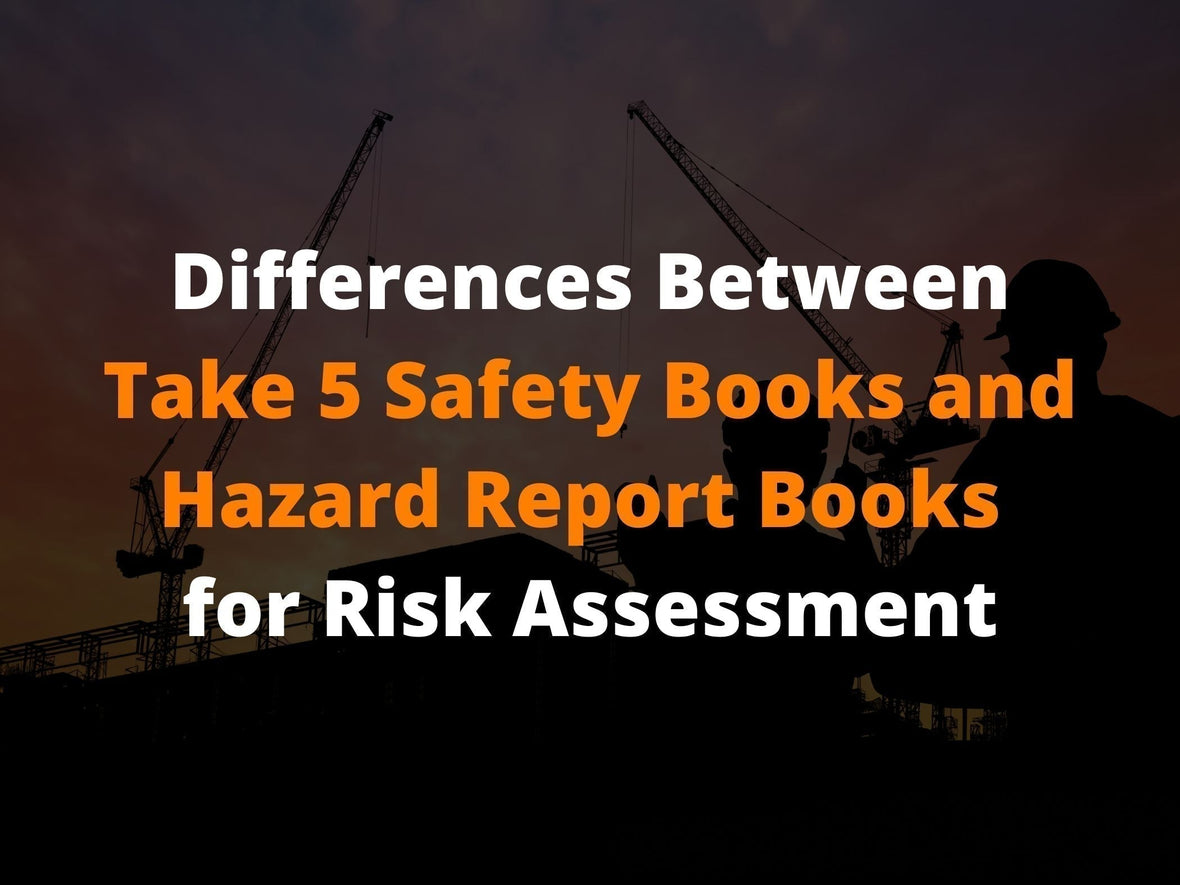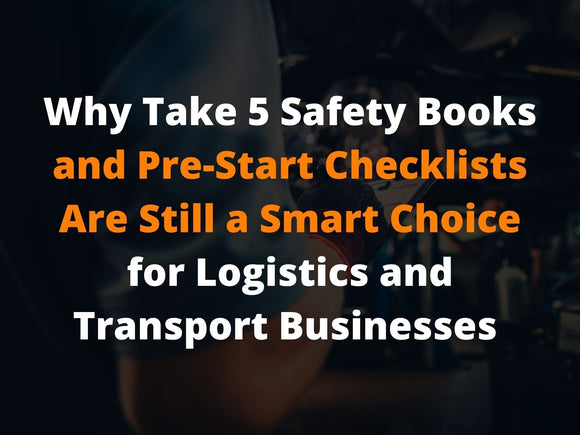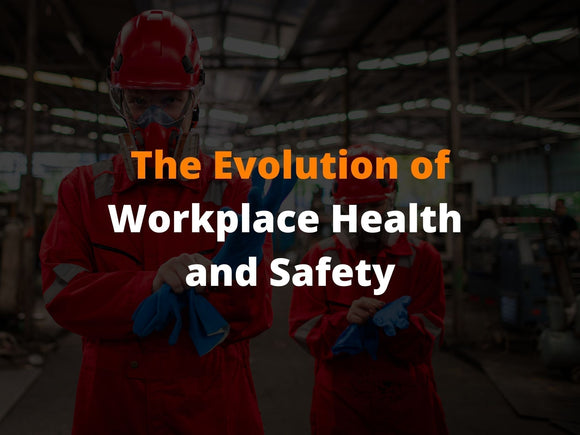
Differences Between Take 5 Safety Books and Hazard Report Books for Risk Assessment
Sales UniprintSafety documentation is essential in high-risk workplaces. Not only does it help save lives, but it also ensures companies stay compliant and constantly improve conditions for their workers. Two of the most important pieces of safety documentation available from UniPrint are the Take 5 Safety books and Hazard Report Books.
However, they’re only effective if they’re used correctly and at the right moment. Understanding the differences between these two tools is crucial for successful safety management and risk assessment.
In this article, we’re going to take you through the key differences and similarities between these two important pieces of safety documentation, so you can create a collaborative safety culture in the workplace.
What Are Take 5 Safety Books?
A Take 5 Safety Book is a well-renowned risk assessment tool that’s used to identify immediate hazards. They’re quick and easy to complete and are pocket-sized, so all workers can have access to them when they need. They’re typically used on-site before beginning any potentially hazardous task, such as using machinery, carrying out electrical work, working from heights or lifting heavy or awkward items.
Not only do Take 5 Safety Books help employees to safely identify risks but they also help to create a positive workplace safety culture. Workers know what the risk management standards are and the books help create awareness.

What Are Hazard Report Books?
Hazard Report Books are a reporting system used to document hazards and risks observed in the workplace. Unlike Take 5 Safety Books, they’re not used to assess possible risks before carrying out hazardous tasks, but rather they’re a way of reporting risks once they’ve been identified.
They usually include a hazard description, location, risk rating and recommended controls. For instance, if a loose handrail on a stairwell is noted, and it’s considered high risk, the worker can recommend to management that the stairwell be cordoned off and the handrail fixed immediately. If it’s considered minimal risk, a different company protocol can be carried out.
Key Differences Between Take 5 Safety Books and Hazard Report Books
Difference #1: Purpose and Timing
A key difference between the hazard identification tools is timing. Take 5 Safety Books are carried out pre-task and are a preventative measure. Hazard Report Books, however, are reactive or proactive. They can be continuously carried out, whenever a hazard is identified, to help management know the risk level.
Difference #2: User and Responsibility
Take 5 Safety Books need to be completed by the person or team performing the task. The emphasis behind the books is on self-led risk assessment, which reinforces its importance amongst all employees.
Hazard Report Books, however, can be filled out by any worker, regardless of their role. They help to form a culture of shared responsibility, in which everyone is encouraged to speak up about risks or unsafe conditions. The reports are then usually submitted to supervisors or the health and safety team for review and follow-up, which helps to develop a hierarchy of control in the workplace.
Difference #3: Focus
Take 5 Safety Books are much more focused on a specific task. Those filing one out need to concentrate on things such as the location of the task, environmental conditions, equipment status and the required PPE. The hazard and risk assessment is job-specific and includes potential risks that may be overlooked in a broader safety plan.
Hazard Report Books focus on a wide range of hazards that may affect multiple workers or areas over time. They encourage management to spot trends and system-wide risks that require longer-term controls. This may include poor lighting, faulty equipment, damaged furniture, chemical spills, trip hazards or missing safety posters or signage.
Difference #4: Outcome
The end goal of filling out a Take 5 Safety Book is assessing whether it’s safe to continue with the task or not. The individual or team will need to decide at that moment. Hazard reports, however, are often escalated to a safety team or management for them to decide on how to proceed, according to company protocol.
Difference #5: Documentation and Use Frequency
Safety Books need to be carried out frequently and, in some instances, daily. Depending on how often the task is carried out or the machinery is used, daily Take 5 Safety Books can help to identify minor hazards before they become serious problems. Hazard Report Books, however, can be completed as needed based on observations from the worker.

Similarities Between Hazard Report Books and Take 5 Safety Books
Similarity #1: Contribute to Risk Assessment and Hazard Awareness
Both are crucial tools in helping improve safety at work. They can be used together to help prevent accidents from happening and report hazards efficiently, so they can be addressed and fixed.
Similarity #2: Worker Engagement
Making health and safety front of mind for busy workers isn’t always easy. Both Take 5 Safety books and Hazard Report Books are easy to fill out, don’t take up much time and are small and robust. They can easily become part of daily health and safety routines to minimise risks in the workplace, which encourages workers to use them.
Similarity #3: Support for Legal and Regulatory Compliance
In many industries, such as mining, safety procedures are a legal requirement to ensure regulatory compliance. Companies can face serious consequences if health and safety documentation isn’t properly completed and hazard identification and reporting haven’t been dealt with efficiently.
Similarity #4: Customisable Options
One of the best ways to encourage workers to actively use both health and safety tools is to make them customisable. At UniPrint, we offer customised Take 5 Safety Books and Hazard Report Books, which can include unique numbers, meeting points, logos, brand colours, specific next steps and multiple languages.
Final Thoughts: Essential for Effective Risk Assessment in The Workplace
Take 5 Safety Books and Hazard Report Books are both forms of effective risk assessment and hazard identification in the workplace. One is carried out routinely for focused tasks, and the other is used for more general hazard identification and reporting in different locations. Both play a huge role in workplace safety and need to be used together.
If you’d like to learn more about both tools, get in contact with the team at UniPrint. We’ll be happy to advise on their best uses and create customised solutions for your company.



